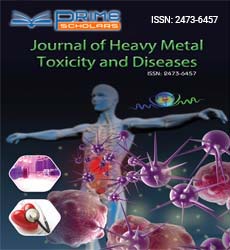Perspective - (2024) Volume 9, Issue 5
Genetic Susceptibility: Understanding the Role of Genetics in Heavy Metal Toxicity
Martin Roll*
Department of Behavioural Science, King Saud University, Saudi Arabia
*Correspondence:
Martin Roll,
Department of Behavioural Science, King Saud University,
Saudi Arabia,
Email:
Received: 01-Oct-2024, Manuscript No. ipjhmct-24-21858;
Editor assigned: 03-Oct-2024, Pre QC No. ipjhmct-24-21858 (PQ);
Reviewed: 17-Oct-2024, QC No. ipjhmct-24-21858;
Revised: 22-Oct-2024, Manuscript No. ipjhmct-24-21858 (R);
Published:
29-Oct-2024, DOI: 10.21767/2473-6457.24.5.45
Introduction
Heavy metal toxicity is a complex public health issue influenced
by environmental factors and individual genetic predispositions.
Metals such as lead, mercury, arsenic, and cadmium can have
severe health consequences, including neurological damage,
developmental disorders, and cancer. While exposure to these
toxins is a significant risk factor, genetic susceptibility can
determine how individuals respond to heavy metal exposure.
This article explores the role of genetics in heavy metal toxicity,
highlighting key genes, mechanisms, and implications for
prevention and treatment.
Description
Heavy metals are naturally occurring elements that can be toxic
at elevated levels. They enter the human body through various
routes, including inhalation, ingestion, and dermal contact.
Once inside the body, these metals can accumulate in tissues,
leading to adverse health effects. The severity of these effects
often varies widely among individuals, with some experiencing
significant toxicity while others remain largely unaffected after
similar exposures. Genetic susceptibility refers to the variations
in genes that influence an individual’s response to environmental
toxins. The body has evolved mechanisms to detoxify harmful
substances, including heavy metals. Genes involved in these
pathways can significantly impact individual susceptibility.
Genetic variations in metal transport proteins can influence how
metals are absorbed and distributed in the body. Mutations in
this gene can lead to Wilson’s disease, characterized by copper
accumulation and toxicity. Heavy metals can induce oxidative
stress, leading to cellular damage. Genetic polymorphisms
in genes related to the oxidative stress response, such as
those encoding antioxidant enzymes can modulate individual
susceptibility to metal-induced toxicity. Exposure to heavy
metals can cause DNA damage, and the efficiency of DNA repair
mechanisms can vary among individuals. Individuals with specific
variants exhibit higher blood lead levels and greater neurological
impairments compared to those without these variants. A study
of Indigenous populations exposed to mercury through fish
consumption found that genetic factors significantly influenced
mercury accumulation and associated health effects. Variants in
genes related to mercury metabolism were linked to increased
susceptibility, suggesting a need for tailored public health
interventions. In regions where arsenic contamination of drinking
water is prevalent, genetic susceptibility plays a role in health
outcomes. Studies have identified specific gene polymorphisms
that affect arsenic metabolism, influencing the risk of developing
skin lesions, cancer, and cardiovascular disease among exposed
individuals. Genetic testing can identify individuals at higher
risk for heavy metal toxicity, allowing for targeted interventions.
This approach can enhance prevention efforts and inform
treatment decisions based on individual genetic profiles.
Incorporating genetic susceptibility into risk assessments can
improve predictions of health outcomes related to heavy metal
exposure. Policymakers can develop more effective regulations
and guidelines based on this comprehensive understanding.
Conclusion
Genetic susceptibility plays a significant role in the effects of
heavy metal toxicity, influencing how individuals respond to
environmental exposures. Understanding the interplay between
genetics and heavy metal exposure is crucial for developing
effective prevention and treatment strategies. As research
advances, incorporating genetic information into public health
initiatives can lead to more personalized approaches, ultimately
reducing the burden of heavy metal toxicity on affected
populations. By recognizing the importance of genetic factors,
we can better protect vulnerable individuals and promote a
healthier, safer environment for all.
Citation: Roll M (2024) Genetic Susceptibility: Understanding the Role of Genetics in Heavy Metal Toxicity. J Heavy Met Toxicity Dis. 09:45.
Copyright: © 2024 Roll M. This is an open-access article distributed under the terms of the Creative Commons Attribution License, which permits unrestricted use, distribution, and reproduction in any medium, provided the original author and source are credited.

